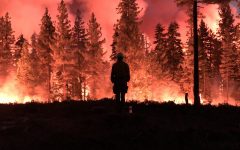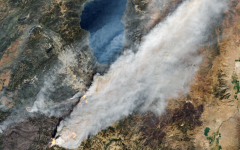
Night operations on the Caldor Fire in September, 2021. An engine crew member monitored the control line of a back burn conducted by Deschutes Engine 636. Photo by Acacia England, U.S. Forest Service (Photo:National Interagency Fire Center)
OPINION: Prescribed Fires Enhance Forest Resilience
Decades of fire exclusion, coupled with the increasing impacts of climate change, have dramatically increased wildfires’ size and intensity
By Brent Skaggs and Craig Thomas, July 16, 2024 12:30 pm
This opinion editorial serves as a rebuttal to “Burn Back Better? USFS Chief’s Letter Of Intent Provokes Revolt In The Firefighting Community“
One of the best methods for reducing the impact of wildfires to the forest is to reduce the number of trees per acre by thinning, leaving the larger trees, and following up with prescribed fire to enhance forest resilience by removing surplus smaller trees that would have acted as ladder fuels and potentially killing the larger trees in a wildfire.
These beneficial fire treatments are well-documented to have slowed or stopped approaching wildfires just like the 2007 Angora wildfire in Lake Tahoe, California, where treatments were documented in aiding firefighters to protect lives and property.
Many of the Forest Service hazard fuel treatments are adjacent to private property where lower fuel loads can reduce wildfire threat to property and communities, and with minimal maintenance, these treatment areas can be viable into the future.
The Forest Service has successful implemented fuel reduction for many decades, therefore not all the 193 million acres in their care need treatment today. Prior to the late 1800’s fire was common in this region (California), with a mean point fire return interval of approximately 8–18 years.
It was the US Forest Service along with many partners who funded and accomplished hazard reduction efforts on the Lake Tahoe Basin Management Unit, years before and after the 2007 Angora wildfire.
The Forest Service and its partners had treated nearly 19,000 acres before the 2007 Angora wildfire. After Angora, these agencies accomplished an additional 36,000 acres by 2013. Of this total, 9,700 acres involved prescribed burning.
It was these fuels treatments and prescribed burning that provided the responding firefighters the opportunity to protect South Lake Tahoe communities from the Caldor wildfire on August 27, 2021.
The Caldor wildfire burned for 69 days, across 221,835 acres, 1,003 structures destroyed, and the evacuation of more than 50,000 residents. Approximately 10,000 acres burned in South Lake Tahoe without burning any structures.
A true success story of these ongoing, prescribed fire policies is from 2016.
On October 29, 2016 the Meadow wildfire was ignited near the Long Meadow Giant Sequoia grove. Firefighters used a confine and contain strategy incorporating the existing road system and planning technical firing operations to bring the Meadow wildfire out to containment roads, eventually burning 4,347 acres over 51 days, achieving low and moderate fire effects. The net result of this wildfire was a reduction of fuel loading and ladder fuels affecting the Cunnington and Long Meadow Giant Sequoia groves.

As the photo above shows, the impact of the destructive 2021 Windy wildfire were minimized in both these Giant Sequoia groves by the reduced fuel loading levels as a result of the 2016 Meadow wildfire.
Out of 15 wildfires that burned in this analysis area between 2010 to 2021, 12 wildfires managed under full suppression objectives (including the 2021 Windy Fire, KNP Complex, and French Fire) produced negative fire effects predominantly outside the natural range of variation (NRV), whereas five wildfires managed for multiple objectives (including resource objectives) resulted in consistently beneficial fire effects within NRV. About 44 percent of the 1.51-million-acre analysis area has been burned in wildfires over roughly the past decade.
The Forest Service has the authority to reduce the build up of hazardous fuels across most of the 193 million acres of National Forest lands, and over the last five-years they have reintroduced beneficial wildfire across 30 million acres of public and private lands.
In 2023, the Forest Service and a wide-range of partners, communities, and tribes treated more than 4.3 million acres of hazardous fuels, including nearly two million acres of prescribed burning, on National Forest System lands across the nation – both are record highs in the agency’s 119-year history and over a million acres more accomplished than the previous year.
These efforts were funded by an investment of nearly $500 million from President Biden’s Investing in America agenda. The Forest Service has the Authority to manage naturally ignited wildfires for resource objectives and that funding is approved by Congress.
The U.S. Forest Service conducts approximately 4,500 prescribed fire projects each year, treating about 1.3 million acres across the National Forest System. Remarkably, 99.84 percent of these prescribed fires go according to plan and remain within their containment lines. However, there is still a small risk—about one escape per every 1,000 prescribed fires, which translates to approximately six escapes per year.
According to the National Interagency Fire Center “Over the past decade, dry years like 2015, 2017 and 2022 showed record years of fire damage as wildfires raged through the West. However, reduced drought conditions in 2023 show that, while the number of fires is comparable to prior years, the number of acres burned to date is much smaller in 2023.”

What is the government doing to address unprecedented and growing forest and wildfire crises?
Decades of fire exclusion, coupled with the increasing impacts of climate change, have dramatically increased wildfires’ size and intensity.
In California, both Cal Fire and the US Forest Service have committed to accomplish 400,000 acres of prescribed fire by the end of 2025 to reduce fuel loading making our Forest and rangelands more fire resilient. After 2025, both Agencies aspire together to treat 1,000,000 acres of forested landscapes each year.
The Agriculture Secretary Tom Vilsack announced in 2023 expanded efforts to reduce wildfire risk across 11 additional landscapes in the western U.S. The funding was provided through the Bipartisan Infrastructure Law (BIL) including several California fire prone landscapes in an ongoing effort to foster fire resilient forest treatments and most importantly to hardwire beneficial fire as the maintenance tool for these forests in perpetuity.
Fires ignited by lightning and Native Americans have been a component of the majority of California ecosystems for thousands of years. Lightning was the most common source of ignitions in California before human populations increased in the mid Holocene.
After this period, ignitions from both lightning and Native Americans were common in many areas before Euro-American settlement in the 19th century.
It is well- documented that before Euro-American settlement 4.5 to 12 million acres burned each year in California creating a resilient forested landscape, with fire limiting the number of trees per acre to mostly large fire resilient trees that would eventually be prized by settlers hungry for Americas top-commodity: lumber.
It is up to the public to motivate and educate and elect our congressional representatives to understand it is well past the time for axe grinding and unproductive bickering – over who is to blame for the condition of our National Forests. Let us step pass the allure of victimhood and get with the program of work outlined in the many ongoing and planned fuels treatment projects listed above.
Let us strive to be engaged community members and continue to support the Forest Service when in “Full Suppression” mode and equally supportive when they are planning and implementing fuels treatments with beneficial fire projects.
We need to armor against the uninformed individuals who throw rocks and promote untrue and misleading characterizations of fuels treatments the Forest Service has accomplished using beneficial fire. It is time we push back and use all our collective influence to cooperatively work together and with the Fire and Smoke Management Agencies to reduce the flammability of California’s and Nevada’s fire-prone landscapes.
- OPINION: Prescribed Fires Enhance Forest Resilience - July 16, 2024





This response is so full of errors (of grammar and facts) and false assertions that it’s actually baffling. These self-described fire experts are writing from gross self-interest and are willfully ignorant of laws, regulations, and policies our shared-former agency must follow in the public interest. Matters of law. Just one example: Congress has never authorized “wildfire use” in any appropriations. They authorize “emergency fire suppression” dollars used under asserted authority by the Forest Service under the now-overturned Chevron deference. There is now no legal basis for wildfire use as we will see in coming litigation.
REBUTTAL: This opinion editorial serves as a rebuttal to Prescribed Fires Enhance
Forest Resilience published recently in The Nevada Globe.
America today is faced with a National Emergency of destructive wildfires on a scale
never been seen before. Not only is this a wildfire crisis but a national emergency for
declining public federal forests that have been under-managed for more than 25 years.
As a result, our forestlands are at very high risk, with about 50% of national forestlands
dead or dying, especially in the West.
In view of current fire conditions and heightened risk posed by excess fuels, we at the
National Wildfire Institute (NWI) believe that allowing a wildfire to burn anywhere, for
any reason, is unacceptable and must be stopped; no exceptions. The risk of an escaped
fire is simply too great.
Balancing wildfire science and wisdom of many decades of experience, NWI believes the
best and indeed only viable strategy under these conditions is this: First put out the fire!
Later, appropriate restorative actions can be undertaking under more suitable
conditions with the responsible use prescribed fire and mechanical treatments to
complete planned work.
Notice how the Prescribed Fires Enhance Forest Resilience opinion piece very carefully
interchanges the words of managed and beneficial fire with Prescribe Fire. Please know
these terms are very different tactics and certainly not interchangeable.
The USDA Forest Service believes in “managed” or “beneficial” or “move to the next best
ridge” or “let it burn” as a grand way to restore ecosystems through the use of fire,
especially if it enables them to meet annual restoration targets by calling burned areas
restorative actions. With half of the public forestland determined to be unhealthy,
especially in the west, these forests are too volatile to let fire burn.
Nevertheless, the Forest Service is unwilling to budge.
There is only one true planned fire for forests. And that is Prescribed Fire, sometimes
illustrated as Rx Fire. Managed or beneficial fire are not planned. Rx Fire is pre-planned
and approved with pre-placement of control forces and lines and done by well qualified
personnel at the right time and the right place and right conditions that allow for a more
optimal method of using fire to remove hazardous fuel buildups.
If nothing changes, the great western forests will become tinder-brush fields by 2045.
So, for the foreseeable future, the only viable firefighting strategy is—First, put out the
fire!
Michael T. Rains worked for the United States Forest Service for almost 50 years,
starting out as a wildland firefighter in California and rising through the ranks to
Deputy Chief of the agency. A Senior FS Executive for over 30 years, Michael is the
primary author of the America’s Forests in the Balance: A National Emergency [aka, A
Call to Action], a document that outlines solutions that address the current National
Emergency. “
THE SUMMARY: A Call to Action, rev. 17.9, July 7, 2024. https://drive.google.com/file/d/1DpCfDbvHcK-RpBgrVvZJ_RGPMuEHmcZt/view